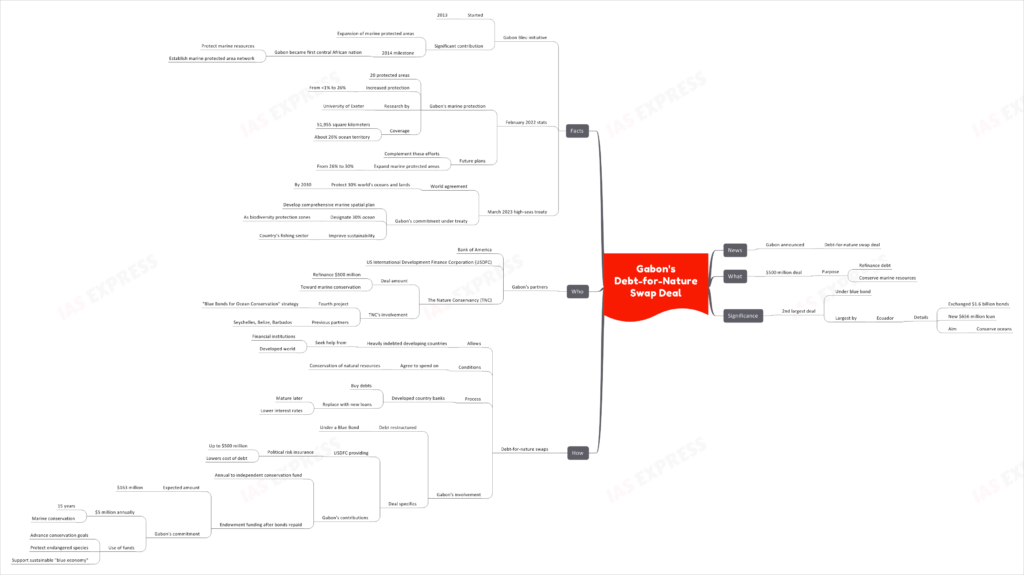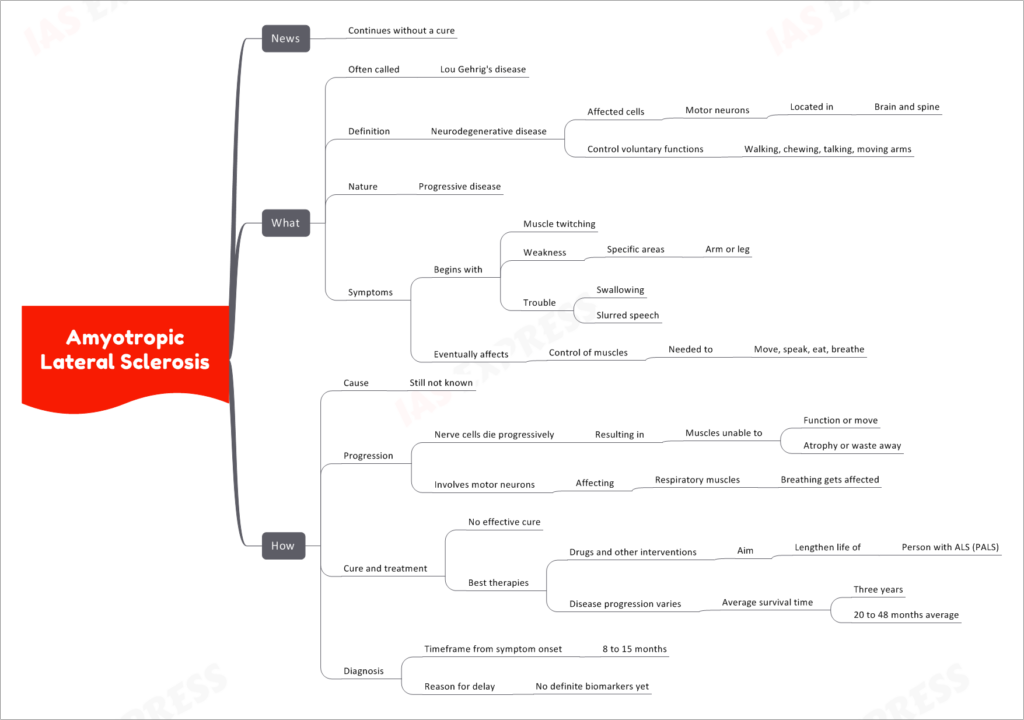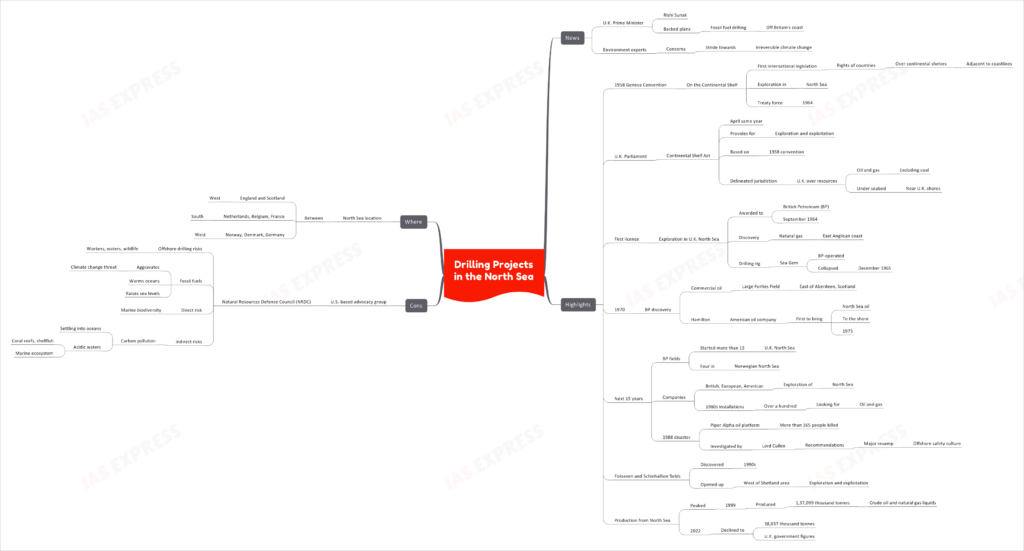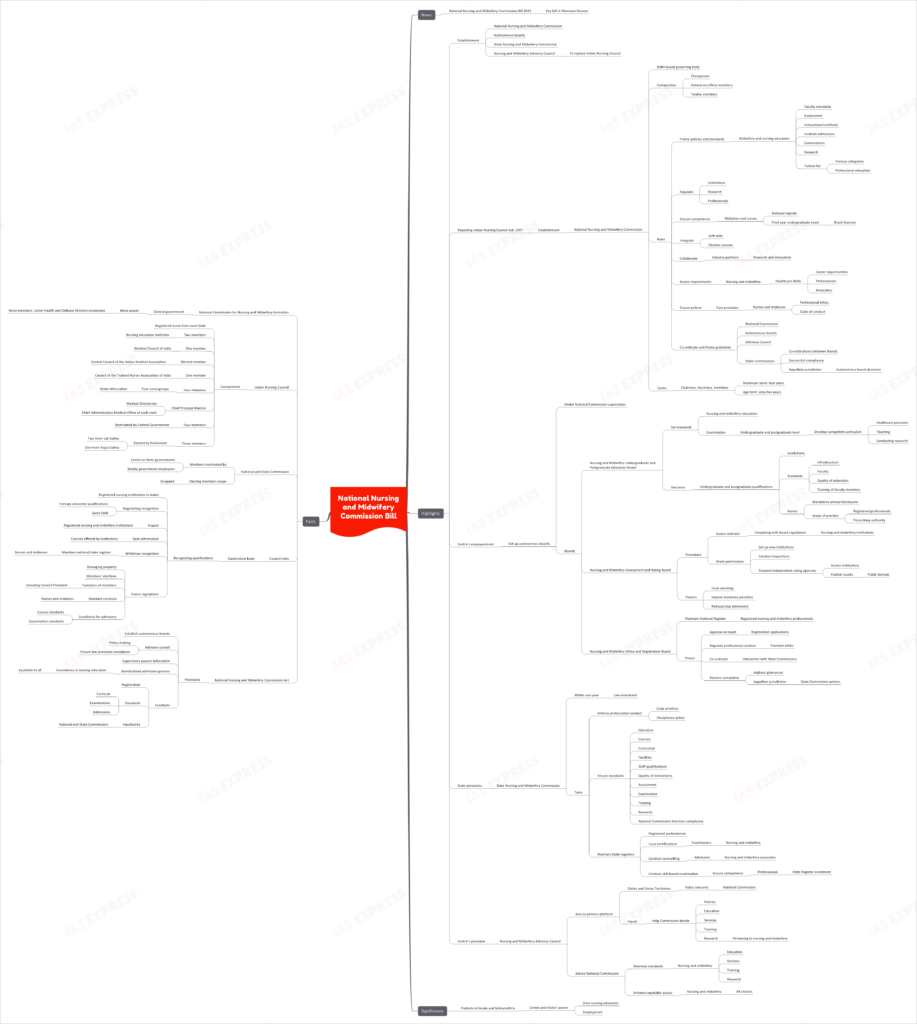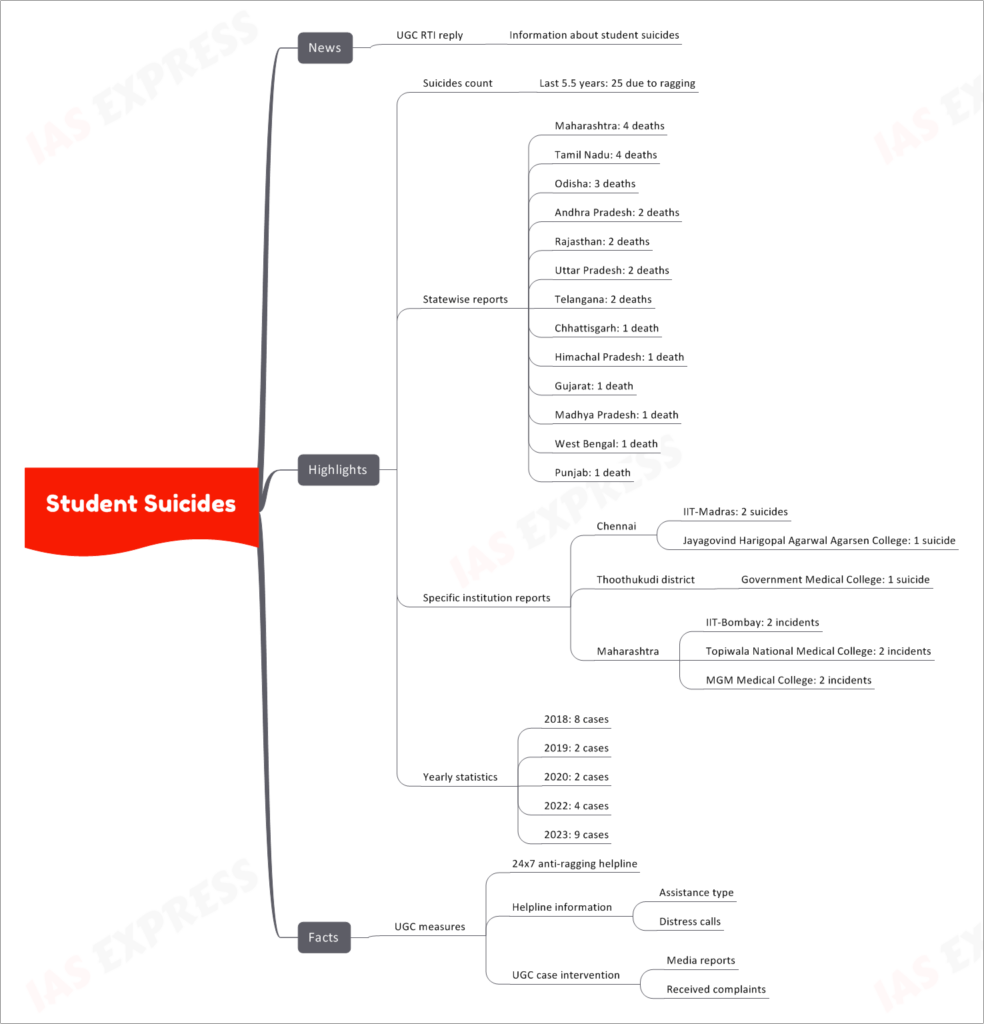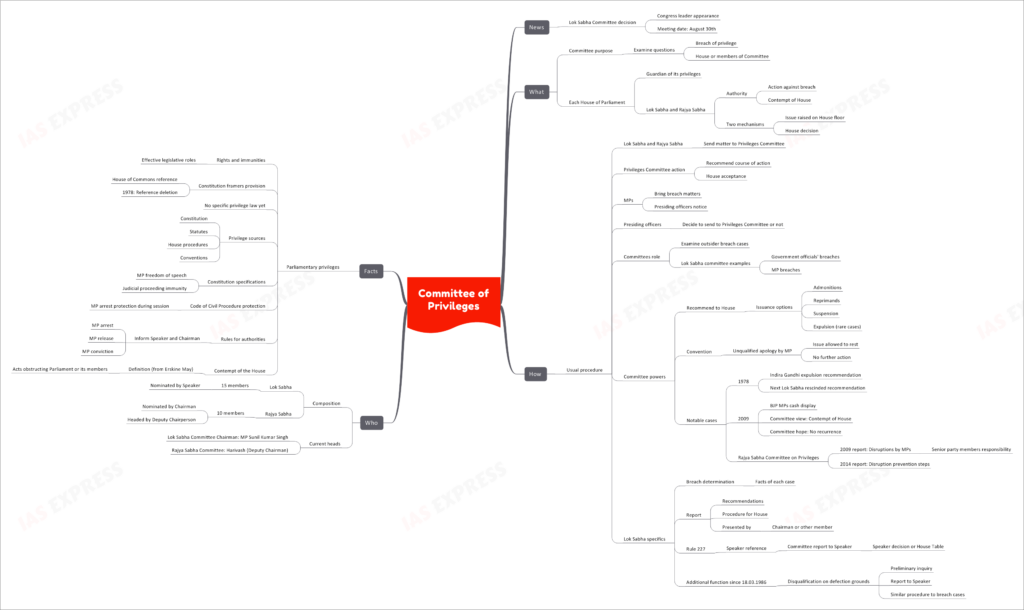[Newsbits] 18.08.2023

Gabon’s Debt-for-Nature Swap Deal
Gabon has publicly announced its participation in a debt-for-nature swap deal, which aims to both refinance national debt and bolster marine conservation efforts.
Overview
The Deal
- Amount: $500 million.
- Primary Purpose: Refinance Gabon’s debt and conserve marine resources.
Significance
- Gabon's deal stands as the 2nd largest under the blue bond initiative, overshadowed only by Ecuador’s previous endeavor:
- Ecuador exchanged bonds worth $1.6 billion for a new loan of $656 million, earmarked for ocean conservation.
Mechanics
- Debt-for-Nature Swaps:
- Allows developing nations grappling with heavy debt to collaborate with financial institutions and developed countries.
- Under these agreements, the participating nations commit to natural resource conservation.
- Developed country banks acquire these debts and provide alternative loans that mature later and often carry reduced interest rates.
- Gabon’s Involvement:
- Gabon's debt was restructured under a Blue Bond.
- Specifics:
- US International Development Finance Corporation (USDFC) offered political risk insurance up to $500 million, reducing Gabon's debt costs.
- Gabon's side of the deal includes annual contributions to an independent conservation fund and an endowment fund post bond repayment, anticipated to reach $163 million.
- Gabon has vowed to provide $5 million annually for 15 years to marine conservation.
- Utilization of the funds will encompass promoting conservation goals, safeguarding endangered species, and buttressing the sustainable "blue economy".
Key Stakeholders
- Gabon's Collaboration Partners:
- Bank of America.
- US International Development Finance Corporation (USDFC).
- The Nature Conservancy (TNC):
- The deal’s amount, a total of $500 million, is directed towards marine conservation.
- For TNC, this marks their fourth project under the "Blue Bonds for Ocean Conservation" strategy. Their prior collaborations were with Seychelles, Belize, and Barbados.
Background & Facts
- Gabon Bleu Initiative:
- Launched in 2013.
- Notable achievements include the expansion of marine protected zones.
- Gabon, in 2014, became the inaugural central African country to take significant measures for marine resource protection by setting up a marine protected area network.
- February 2022 Data:
- Gabon currently boasts 20 marine protected areas.
- Marine conservation zones have expanded from less than 1% to 26%, covering a vast 51,955 square kilometers (approx. 26% of their ocean territory) as found by research from the University of Exeter.
- Gabon's ambitions don’t end here. They plan to elevate their marine protected regions from 26% to a commendable 30%.
- March 2023 High-Seas Treaty:
- A global pact aiming to shield 30% of the world's oceans and lands by 2030.
- Under this agreement, Gabon is on track to:
- Draft a thorough marine spatial strategy.
- Designate 30% of its oceanic expanse as biodiversity protection zones.
- Enhance the sustainable practices within its fishing industry.
Amyotrophic Lateral Sclerosis
Amyotrophic Lateral Sclerosis (ALS), frequently known as Lou Gehrig's disease, is a neurodegenerative ailment for which a cure remains elusive.
What is ALS?
- Alias: Often referred to as Lou Gehrig's disease.
- Definition: A neurodegenerative disorder primarily affecting:
- Motor Neurons: Cells located in the brain and spine that control voluntary functions.
- Functions Controlled: Walking, chewing, talking, and moving arms.
- Nature: It's a progressive disease, meaning symptoms get worse over time.
Symptoms
- Initial Symptoms:
- Muscle twitching.
- Weakness in specific areas, notably in an arm or leg.
- Trouble with swallowing and slurred speech.
- Advanced Symptoms:
- With disease progression, patients lose control over muscles needed for movement, speech, eating, and breathing.
Cause and Progression
- Cause: The exact cause of ALS remains unknown.
- Disease Progression:
- ALS results in the progressive death of nerve cells.
- Over time, muscles lose their ability to function and move, leading to muscle atrophy (wasting away).
- The disease also impacts the motor neurons affecting respiratory muscles, thereby affecting the person's ability to breathe.
Treatment and Prognosis
- Cure: Regrettably, there is no known effective cure for ALS yet.
- Treatment Options:
- The best therapies available presently include drugs and other interventions.
- Goal: To extend the lifespan of a Person with ALS (PALS).
- Disease Progression: It varies for each individual. On average, survival time after diagnosis is around three years, with a broader range of 20 to 48 months.
Diagnosis
- Diagnosis Timeframe: Typically, from the onset of symptoms, it takes about 8 to 15 months to confirm a diagnosis of ALS.
- Delay Reason: A significant factor for this delay is the absence of definitive biomarkers for the disease.
Drilling Projects in the North Sea
The U.K. Prime Minister, Rishi Sunak, recently gave the nod to plans focused on fossil fuel drilling off Britain's coast. However, these plans have ignited concerns among environmental experts, fearing a step towards irreversible climate change.
News Details
U.K. Prime Minister's Stance
- Rishi Sunak's Endorsement:
- Backed the exploration plans of fossil fuel drilling off Britain's coast.
Environmental Concerns
- Expert's Take:
- Expressed serious concerns about the possible push towards irreversible climate change.
Historical Highlights
International Legislation
- 1958 Geneva Convention on the Continental Shelf:
- Introduction:
- The first international legislation granting rights to countries over their adjacent continental shelves.
- Key Points:
- Focus on North Sea exploration.
- Treaty came into effect in 1964.
- Introduction:
U.K. Jurisdiction
- Continental Shelf Act by U.K. Parliament:
- Timeline: Introduced in April of the same year as the treaty.
- Purpose:
- Allows exploration and exploitation based on the 1958 convention.
- Grants U.K. jurisdiction over resources like oil and gas (except coal) under the seabed close to its shores.
Initial Exploration
- First License:
- Recipient: British Petroleum (BP) in September 1964.
- Discoveries:
- Found natural gas off the East Anglican coast.
- Used the Sea Gem drilling rig which unfortunately collapsed in December 1965.
Significant Discoveries
- 1970:
- BP's discovery of commercial oil in the large Forties Field east of Aberdeen, Scotland.
- American oil company, Hamilton, was the first to bring North Sea oil to the shore in 1975.
- Over the Next 15 Years:
- BP initiated over 15 projects in the U.K. North Sea and four in the Norwegian North Sea.
- Several British, European, and American companies delved into North Sea exploration.
- By the 1980s, over a hundred installations were set up in search of oil and gas.
- The tragic 1988 Piper Alpha oil platform disaster claimed the lives of over 165 individuals. Lord Cullen's investigation led to a significant revamp of offshore safety culture.
- Later Discoveries:
- Foinaven and Schiehallion fields were discovered in the 1990s, opening up the West of Shetland area for exploration and exploitation.
Production Data
- Peak Production:
- 1999 saw the highest production with 1,37,099 thousand tonnes of crude oil and natural gas liquids.
- Recent Figures:
- By 2022, production declined to 38,037 thousand tonnes, as per U.K. government data.
Cons of Drilling
- NRDC's Viewpoint:
- The U.S.-based Natural Resources Defence Council (NRDC) highlighted the risks of offshore drilling for workers, the surrounding waters, and wildlife.
- They emphasized that the continued use of fossil fuels exacerbates the climate change threat, warms oceans, and results in rising sea levels.
- Direct risks to marine biodiversity and indirect threats from carbon pollution settling in oceans were mentioned. Acidic waters threaten coral reefs, shellfish, and the entire marine ecosystem.
Geographical Context
Location of the North Sea
- Borders:
- West: England and Scotland
- South: Netherlands, Belgium, and France
- East: Norway, Denmark, and Germany
National Nursing and Midwifery Commission Bill
Recent news has highlighted the pivotal bill introduced in the Monsoon Session - the National Nursing and Midwifery Commission Bill 2023.
Highlights
Establishment
- National Nursing and Midwifery Commission
A significant establishment to take center stage in nursing and midwifery affairs. - Autonomous Boards
Independent entities functioning under the aegis of the main Commission. - State Nursing and Midwifery Commission
State-level counterparts to ensure decentralization of authority. - Nursing and Midwifery Advisory Council
- A council formulated to replace the Indian Nursing Council.
Repealing Indian Nursing Council Act, 1947
National Nursing and Midwifery Commission
- Establishment
- Based in Delhi as the central governing body.
- Composition
- Chairperson: Central leadership figure.
- Ex-officio Members: 16 in number.
- Members: 12 in number, representing various facets of the profession.
- Roles
- Policies and Standards Framing: Relating to midwifery, nursing education including:
- Faculty standards
- Assessment mechanisms
- Instructional methods
- Admissions into institutes
- Exam structures
- Research guidelines
- Tuition fee categories for professional education
- Regulation: Governing institutions, research, and professional standards.
- Ensuring Competence: Establishing a national register and conducting a final year undergraduate exam to grant licenses.
- Integration: Of soft skills and elective courses in the curriculum.
- Collaboration: With industry partners for research and innovation.
- Assessment: Of nursing and midwifery requirements in healthcare fields, focusing on career opportunities and the roles of professionals and associates.
- Guidelines and Coordination: Among National Commission, Advisory Council, Autonomous boards, and State Commissions.
- Policies and Standards Framing: Relating to midwifery, nursing education including:
- Terms of Service
The Chairman, Secretary, and members are limited to a maximum term of four years and an age limit of sixty-five years.
Centre's Empowerment
Autonomous Boards
- Nursing and Midwifery Undergraduate and Postgraduate Education Board
- Setting standards for education, and exams at both undergraduate and postgraduate levels.
- Making decisions regarding the institutions' infrastructure, faculty quality, and education quality.
- Instituting norms for mandatory annual disclosures and scope of practice for registered professionals.
- Nursing and Midwifery Assessment and Rating Board
- Procedures to assess and rate nursing institutions.
- Granting permissions for setting up new institutions and conducting inspections.
- Powers to issue warnings, impose penalties, or regulate admissions.
- Nursing and Midwifery Ethics and Registration Board
- Maintaining a national register.
- Powers to approve or reject registration applications.
- Regulation of professional ethics and conduct.
State Provisions
State Nursing and Midwifery Commission
- Establishment: Within a year of the law's enactment.
- Roles: Enforcing professional ethics, ensuring educational standards, maintaining state registers, and facilitating admissions counseling.
Centre's Provision
Nursing and Midwifery Advisory Council
- Function: Primary platform for states to voice concerns.
- Role: Advising the National Commission on maintaining standards in nursing and midwifery education, services, and research.
Significance
The bill has sparked protests in Kerala and Maharashtra, emphasizing the contention between the center and states over nursing education and employment authority.
Facts
- The Central government will have increased power with most members of the National Commission for Nursing and Midwifery being Union Health and Defence Ministry employees.
- The Indian Nursing Council had a diverse composition from various medical and nursing sectors.
- The new National and State Commission will mainly comprise government employees with the scope of electing members eliminated.
- The Council’s previous roles involved recognizing qualifications, inspecting institutions, and framing regulations. These responsibilities are now under the National Nursing and Midwifery Commission Act's purview.
Student Suicides
Recent news has brought to light a deeply concerning issue plaguing the education system – student suicides. A recent reply to an RTI query by the University Grants Commission (UGC) has shed light on the distressing prevalence of student suicides in the past few years. The statistics reveal a grim reality that demands urgent attention.
Highlights: The Stark Numbers
The UGC's RTI reply has revealed shocking numbers regarding student suicides, particularly those attributed to ragging. Over the past 5.5 years, there have been 25 reported suicides due to ragging. These numbers paint a distressing picture of the mental health challenges students are facing within the educational environment.
Statewise Reports
The suicides are not limited to any particular region, as evidenced by statewise reports:
- Maharashtra: 4 deaths
- Tamil Nadu: 4 deaths
- Odisha: 3 deaths
- Andhra Pradesh: 2 deaths
- Rajasthan: 2 deaths
- Uttar Pradesh: 2 deaths
- Telangana: 2 deaths
- Chhattisgarh: 1 death
- Himachal Pradesh: 1 death
- Gujarat: 1 death
- Madhya Pradesh: 1 death
- West Bengal: 1 death
- Punjab: 1 death
Specific Institution Reports
Numerous institutions across India have been affected by this troubling trend:
- Chennai:
- IIT-Madras: 2 suicides
- Jayagovind Harigopal Agarwal Agarsen College: 1 suicide
- Thoothukudi district:
- Government Medical College: 1 suicide
- Maharashtra:
- IIT-Bombay: 2 incidents
- Topiwala National Medical College: 2 incidents
- MGM Medical College: 2 incidents
Yearly Statistics
The yearly statistics paint a stark picture of the evolving crisis:
- 2018: 8 cases
- 2019: 2 cases
- 2020: 2 cases
- 2022: 4 cases
- 2023: 9 cases
Facts: Addressing the Issue
The UGC has taken measures to address the concerning rise in student suicides:
- 24x7 Anti-Ragging Helpline: The UGC has established a helpline to combat ragging, providing assistance round the clock.
- Helpline Information: This helpline offers various forms of assistance, including counseling for distressed students and a platform for reporting distress calls.
- UGC Case Intervention: The UGC intervenes based on media reports and received complaints, working to address issues that come to its attention.
Committee of Privileges
Recent news has highlighted the pivotal role played by the Committee of Privileges within the Indian parliamentary system. This committee is entrusted with maintaining the integrity of parliamentary proceedings and upholding the privileges of its members. The Lok Sabha Committee's recent decision to examine a breach of privilege involving a Congress leader's actions has once again brought attention to its significance.
What is the Committee of Privileges?
The Committee of Privileges holds a crucial position in the Indian parliamentary framework. Its main purpose is to examine questions concerning breaches of privilege, whether these involve the House itself or its individual members. Every House of Parliament, be it the Lok Sabha or the Rajya Sabha, acts as the guardian of its privileges. These privileges encompass various rights and immunities that enable members to effectively fulfill their legislative roles.
Authority and Mechanisms
Both the Lok Sabha and Rajya Sabha have the authority to take action against breaches of privilege and contempt of the House. Two mechanisms are in place to address such matters:
- Issue Raised on the House Floor: Any breach of privilege can be raised on the floor of the House.
- House Decision: The House decides whether the matter should be referred to the Privileges Committee.
How Does the Committee Function?
The usual procedure for addressing breach of privilege matters involves:
- Lok Sabha and Rajya Sabha sending the matter to the Privileges Committee.
- The Committee recommending a course of action, subject to the House's acceptance.
- MPs bringing breach matters to the attention of presiding officers.
- Presiding officers deciding whether the matter should be referred to the Privileges Committee.
The Committee plays a significant role in examining breach cases, including those involving outsiders. Some notable examples from the Lok Sabha include breaches by government officials and MPs. The Committee has the power to recommend various actions, such as admonitions, reprimands, suspension, and even expulsion (in rare cases).
Convention and Notable Cases
An interesting convention involves the unqualified apology by an MP. If the MP apologizes, the issue can be allowed to rest without further action. Notable cases in the Committee's history include the 1978 recommendation for Indira Gandhi's expulsion, later rescinded by the next Lok Sabha. In 2009, the Committee addressed BJP MPs' cash display and expressed hope for no recurrence. The Rajya Sabha Committee on Privileges also has reports from 2009 and 2014, focusing on disruptions and prevention steps.
The Lok Sabha specifics entail a thorough determination of breach facts and a subsequent report containing recommendations, procedure details for the House, and presentation by the Chairman or other members. Rule 227 empowers the Speaker to refer the Committee's report, and the Speaker's decision or the House's table follows this.
An additional function since March 18, 1986, involves disqualification on defection grounds, following a preliminary inquiry and reporting to the Speaker.
Who Comprises the Committee?
The Committee's composition is significant in ensuring impartiality and diverse representation. In the Lok Sabha, there are 15 members nominated by the Speaker, while the Rajya Sabha has 10 members nominated by the Chairman, with the Deputy Chairperson heading the committee.
Current Heads
As of now, the Lok Sabha Committee is chaired by MP Sunil Kumar Singh, and the Rajya Sabha Committee is led by Harivash, the Deputy Chairman.
Parliamentary Privileges in Perspective
Parliamentary privileges encompass the rights and immunities granted to members, allowing them to fulfill their legislative duties effectively. These privileges find their origin in the Constitution, statutes, house procedures, and conventions. The Constitution specifies the freedom of speech for MPs and provides immunity in judicial proceedings.
Protecting MPs' Rights
The Code of Civil Procedure extends protection to MPs during sessions, shielding them from arrest. Rules dictate that authorities must inform the Speaker and Chairman regarding an MP's arrest, release, or conviction. Contempt of the House is defined as acts obstructing Parliament or its members, as outlined by Erskine May.
If you like this post, please share your feedback in the comments section below so that we will upload more posts like this.
